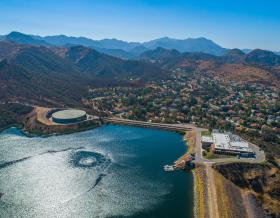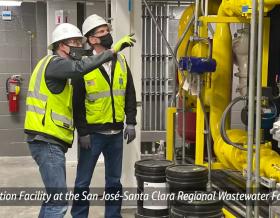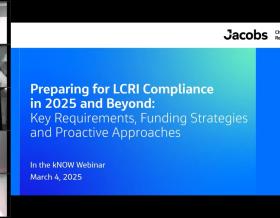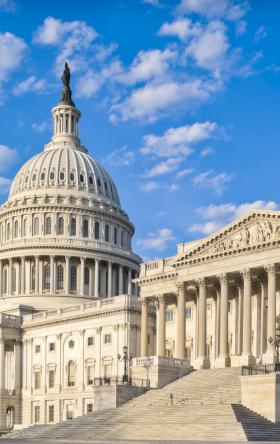
In May 2025, the U.S. Environmental Protection Agency (EPA) announced its intent to revise the national primary drinking water regulation for per- and polyfluoroalkyl substances (PFAS). Proposals to extend compliance deadlines and revisit certain regulated limits received a mixed response. While some industry groups welcomed the changes, public health and environmental advocates vowed to challenge any rollback in court.
With the Safe Drinking Water Act’s anti-backsliding provisions in place, litigation seems likely, but the April 2024 rule remains enforceable until a new rule is finalized. For drinking water systems, one thing remains certain: compliance planning can’t wait.
In a recent In the kNOW webinar, Jacobs explored how water systems can stay ahead of this evolving regulatory landscape. Katie Walker, Jacobs’ global principal for PFAS, shares key takeaways.
EPA’s May 2025 announcement: What’s changing
In April 2024, the EPA finalized enforceable maximum contaminant levels (MCLs) for five PFAS compounds in drinking water, including perfluorooctanoic acid (PFOA) and perfluorooctanesulfonic acid (PFOS) at 4 parts per trillion (ppt). The rule also introduced a hazard index approach for four PFAS. Utilities were given a phased compliance schedule through 2029, starting with source monitoring and public notification.
On May 14, 2025, the EPA announced a new rulemaking process that proposes to:
- Maintain the current MCLs for PFOA and PFOS
- Rescind and reconsider the MCLs for GenX or hexafluoropropylene oxide dimer acid (HFPO-DA), perfluorononanoic acid (PFNA) and perfluorohexanesulfonic acid (PFHxS)
- Rescind and reconsider the hazard index calculation
- Extend the treatment compliance deadline from 2029 to 2031
- Offer new technical support and funding access (without additional federal funds)
- Propose a federal exemption framework for small or rural systems
A draft rule is expected in fall 2025, with a final rule in spring 2026. Until then, the April 2024 rule remains enforceable.
Compliance timeline and monitoring
Even with a proposed treatment deadline extension to 2031, the EPA has not delayed monitoring or reporting requirements. Water systems must still:
- Complete initial monitoring by 2027
- Conduct routine quarterly (or adjusted frequency) monitoring
- Include PFAS results in Consumer Confidence Reports (CCRs)
- Begin public notifications for sampling or notification violations
Critically, systems with PFOA or PFOS detections above the 4 ppt should evaluate options for treatment, possibly by 2028, to ensure compliance with the rule’s running annual average (RAA) requirement.
Why the RAA matters
Unlike regulations that rely on single-sample results, PFAS compliance is based on a four-quarter RAA. This approach is similar to how the EPA regulates disinfection byproducts, allowing some flexibility to offset seasonal or event-based spikes. This means that utilities may need to begin treatment well before the formal compliance date to ensure that their RAA meets the regulation.
Jacobs’ webinar shared modeling examples to illustrate how this works. A system slightly above 4 ppt might only need one quarter of treatment prior to the regulatory deadline to achieve compliance. Systems above 10 ppt may need up to a full year of early treatment.
This reinforces the need for early planning – even amid regulatory uncertainty.
Strategies for staying ahead
Water systems can take proactive steps to prepare for both current and future PFAS regulations:
-
Assess your risk
Compile existing PFAS monitoring data – especially if collected under Unregulated Contaminant Monitoring Rule (UCMR) 5 – and rank drinking water sources by risk. Prioritize systems or supplies where average levels approach or exceed the 4 ppt MCLs, or evaluate alternative options below the regulatory limits.
-
Pilot and compare treatment options
Evaluate proven technologies like granular activated carbon (GAC), ion exchange and selective adsorbents. Pilot testing helps determine media life, performance under specific water quality conditions and fouling risks.
-
Model for RAA compliance
Use pilot and source water data to simulate treatment timelines. Calibrated models can project PFAS breakthrough and guide cost-effective media replacement.
-
Plan for capital and operational needs
Larger systems may need facility upgrades such as intermediate pumping, parallel vessels or gravity contactors, or additional backwashing capabilities. Smaller systems may benefit from pre-engineered modular systems. Interim strategies like powdered activated carbon (PAC) dosing may also prove beneficial, though long-term viability varies.
-
Monitor state-level actions
While the federal rule is still evolving, several states may enact stricter or different PFAS standards. Stay informed about local policies and requirements that may impact your systems ahead of federal deadlines.
Final thoughts
Drinking water systems with PFOA or PFOS levels near the MCL should not wait to act. Delays can increase long-term costs and limit flexibility. Strategic planning, pilot testing and early investment in treatment technologies can help utilities protect public health, maintain trust and ensure compliance—even amid regulatory uncertainty.













































